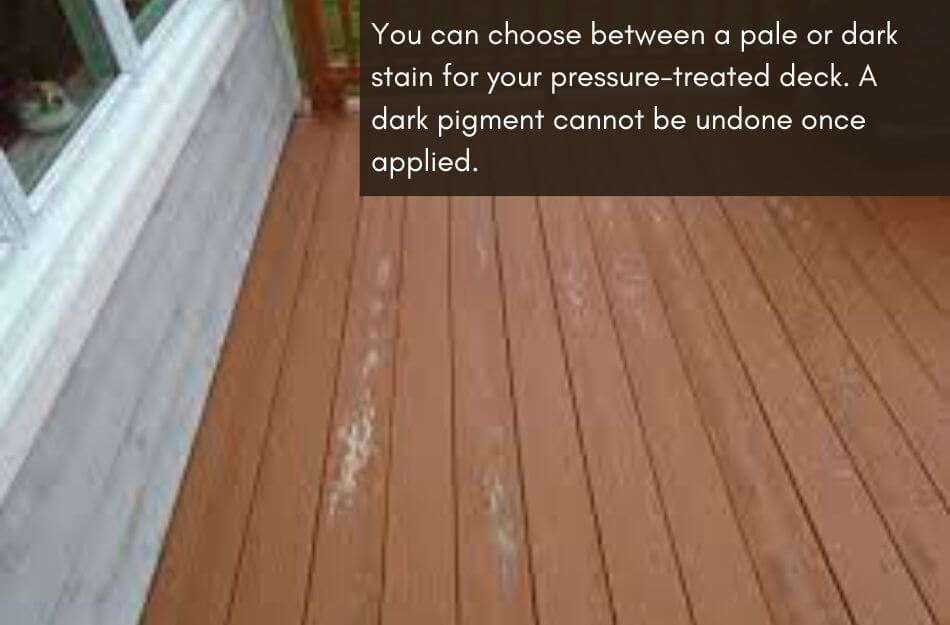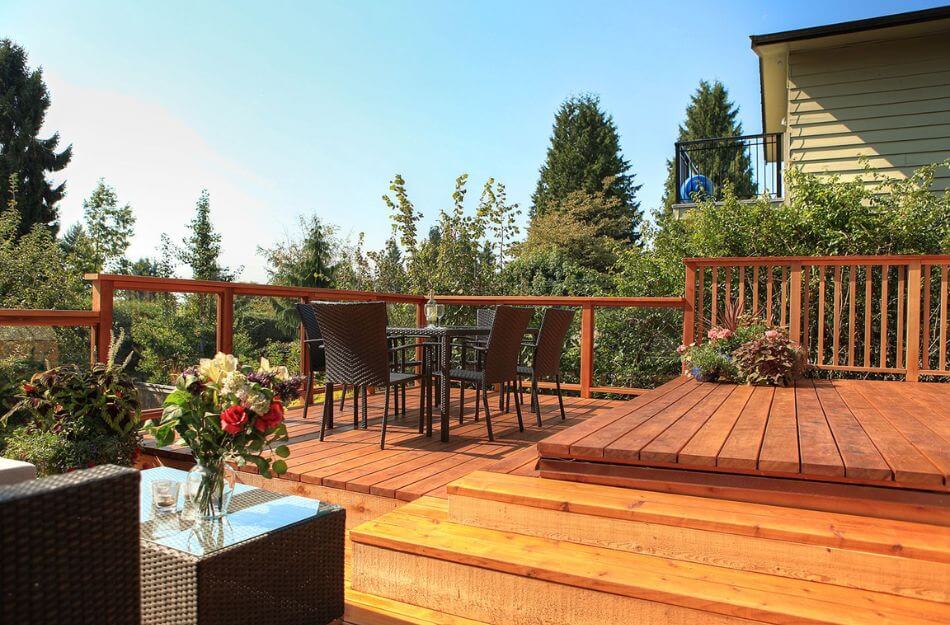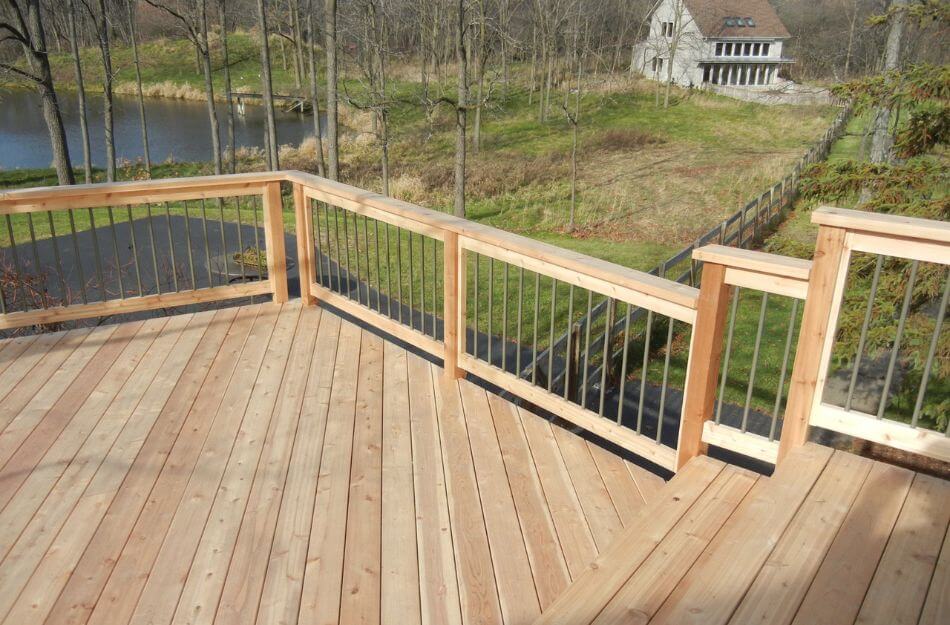To safeguard the deck floor from fungus, mold, and other damages, many householders choose to stain it. However, picking a hue for your deck’s wood can be challenging.
Choosing a color for the exterior and one for the inner deck floors is difficult. As a result, many are curious about the finest and most appealing pressure-treated wood colors.
You can choose between a pale or dark stain for your pressure-treated deck. A dark pigment cannot be undone once applied. Therefore, whenever painting a new wooden deck, choose lighter colors. Use bright colors instead of dark ones to stain aging deck floorboards because the latter can conceal unsightly flaws.

Pressure-treated deck floors can be stained with several products. However, each stain offers your home’s decor a distinctive feel. To make your deck appear appealing, you must pick the right color for it.
The aftereffects of well-known stains are the main topic of this article. Let’s examine which shade is ideal for painting your deck and why.
Table of Contents
- 1 Popular Stain Color For Pressure Treated Wood
- 2 Can You Stain Pressure-treated Wood?
- 3 What to Look When Choosing The Best Stain Color for a Pressure Treated Wood
- 4 Benefits of the Best Stain Colors for Pressure-Treated Wood
- 5 When Should Pressure Treated Wood Be Stain?
- 6 Best Wood Stain for the Exterior
- 7 Final Thoughts
Popular Stain Color For Pressure Treated Wood
Staining your treated wood is essential to protect your wood from many different factors.
That’s why for a better appearance of your wood you need the best stain color, however, it is difficult to choose the right stain color for your treated wood. Don’t worry we have compiled the poplar stain colors for you.
Cedar Tones and Semi-Transparent Colors
One of the most common deck hues is cedar tone and semi-transparent color.
As a general rule, it is best to start with the color that dominates your yard and work your way out, but with cedar, it is difficult to go wrong. The color is ideal for chilly winter nights and not dark, needed to be dark summer days.
Brown Tones and Semi-Transparent Colors
Brown occasionally receives an unfair image as a color that lacks creativity or vibrancy. This hue may shine in your garden if you use it.

It’s essential to note that lighter and brighter furniture and accessories should be used to highlight the rich natural qualities of a brown deck stain. A stunning, visually pleasing deck will result from finding the ideal match.
Honey Tones and Semi-Transparent Colors
A soft shade like honey will enhance the deck’s natural-looking grain. Since frequent rain can make this color deck stain dark and dull, it is popular in regions with year-round sunshine.
Use this color cautiously if you live in a region where showers are common or are close to the ocean. Consider buying a gazebo to help preserve the color.
Redwood Tone and Semi-transparent Colors
Like darker deck stain colors, redwood should be combined with light hues to highlight its lovely ruby undertones.
A semi-strong hand is a great semi-transparent redwood stain alternative because the softer hue lets you see the intricate wood underneath and blends well with any color scheme.
When treated correctly, this eye-catching color will last for many years. Still, if left to weather, it can fade to an iron grey, so be cautious to safeguard and maintain your deck as needed.
When selecting a new deck stain, think about using a color guide.
These helpful tools assist by demonstrating which colors complement your garden’s existing colors and discovering the ideal match with some thought.
Can You Stain Pressure-treated Wood?
Pressure-treated wood can be stained using a few different methods. One option is to use a semi-transparent deck stain, allowing some of the wood’s natural grain to shine.
A solid-color deck varnish is another option for a more even appearance. Another option is a clear sealer, which will shield the wood without affecting its appearance.
Some stains may react with the treatment’s chemicals and change to yellow or brown. The treatment can also stop stains from penetrating the wood, which would produce an uneven surface.
The ideal remedy is to use a color designed for pressure-treated wood. Whatever option you select, adhere to the manufacturer’s directions to ensure the best results.
What to Look When Choosing The Best Stain Color for a Pressure Treated Wood
Before choosing the finest deck stain for pressure-treated wood, you must comprehend how the wood was treated before you choose the best stain for your pressure-treated wood, taking into account the variables listed below.

We all adore decks because they allow us to relax and sip coffee on chilly summer mornings. A deck made of pressure-treated wood, whether it is new or ancient, cannot rot. However, to protect it from the weather, you’ll need to stain it.
Paint Size/Amount in a Can
It’s always preferred to buy stains in large quantities. The addition is always good notionally; if you have any extras, you could offer them through Craigslist or a local Facebook market.
Getting enough stain to complete your job is essential. Additionally, you’ll probably apply several layers of paint to most pressure-treated wood.
Remember that some sections, like the edges, will need more stain than others. Keep in mind that a typical deck is 350 square feet.
It’s great to obtain a deck stain with this much coverage or more to reduce the number of cans you need to buy and save money.
Keep an Eye on the VOC Content Level of a Stain
Volatile organic compounds (VOCs), which are assessments of hazardous gases produced as vapor. When choosing a wood stain, you should keep in mind that almost all VOCs are hazardous.
Choose a low VOC stain because it is safe for you, your dogs, and the environment. When staining the wood, you must wear a mask or a respirator to keep you from inhaling harmful fumes.
Wood Type You Wish to Stain
It’s important to understand the sort of wood used in your deck and how it was treated to prevent rot. Recognize whether it is softwood or oak.
Has it undergone pressure, moist treatment, kiln-dried pressure treatment, or the addition of water repellent?
It depends on the wood type you have, whether you need a deep stain or not because some woods are more porous than others. In some cases, the outcome is influenced by the wood’s age.
You can choose the appropriate stain if you are aware of the sort of wood you are working with and how it was treated.
Opacity
Understanding opacity is essential for determining how a pigment will affect the design of your deck. Opacity refers to how the natural wood grain will look on the deck design.
You can use the following stains to accomplish opacity.
- A sizable portion of the grain and structure can be seen through the semi-transparent stain. The color is also slightly more prominent at the same moment.
- Transparent/clear stains don’t have any color, bringing out the Wood’s inherent beauty.
- Having only the lightest tone, translucent stains do not hide the Wood’s grain or structure.
- Semi-solid stain conceals most defects while allowing some of the Wood’s grain and structure to show through, thanks to its darker shades.
You can rapidly learn how to make stained wood that is dark and lighter to achieve your preferred shade if your deck appears too opaque for your tastes.
Pigment Quality
An important factor in the overall color quality is pigment quality. All premium stains offer excellent UV protection for the Wood and can’t discolor, chalk, or change color. They all contain 100% iron oxide pigments.
The Wood can be treated naturally and stained with high-quality, oil- or water-based stains to preserve its beauty and safeguard it from the elements.
Don’t Miss: When To Stain A New Deck: Ultimate Deck Staining Guide
Benefits of the Best Stain Colors for Pressure-Treated Wood
Substances prevent bug infestation and decay in pressure-treated or outdoor wood.

This procedure permits customers and the forest industry to use lower-grade wood rather than increasing demand for cedar, redwood, or cypress.
These lower varieties have a more obvious grain, unlike Wood, which is naturally extremely resistant to rot and insects. Compared to cedar or redwood, they are more apt to splinter and break.
Even if the Wood has been chemically treated, you should stain the object as soon as it is completely dry, or at the very least, use a water-repellent. Here are some advantages of pressure-treating wood.
Avoid Rotting From the Beginning
Wood will rot if it is exposed to the weather without being sealed. Rot can place wood projects at risk of collapsing and give them a bad appearance. The rot is caused by termites, mold, and mildew on wood.
Unfortunately, there is no way to halt the rot once it has begun. Pressure-treated wood must be stained, and coats must be applied again regularly to prevent decay. Additionally, staining shields the wood from the sun and rain.
Less Expensive to Stain
Decks and other external walking areas are perfect for wood flooring. Even so, the environment here exposes it to more deterioration and wear due to foot activity.
Despite being a feasible option, there are better options than paint due to its poor durability.
With time, the paint may start to chip and crack, denting the look and exposing the wood to harsh elements. Contrarily, sealant takes longer to dry and costs less to apply before needing upkeep.
Maintain the Wood’s, Natural Beauty
The grain in the wood lends it a beautiful look by nature. The pressure-treated Wood can be stained to give additional weather resistance while letting the natural grain show through.
Additionally, stains come in various hues, and you can mix and match colors to achieve the desired tone. Additionally, there are uncolored and untinted stains that do not change the wood appearance.
When Should Pressure Treated Wood Be Stain?
Some pressure-treated woods are theoretically still wet, and they can only be stained once they have had time to cure.
Be cautious, though, as the longer this green-colored material is exposed to the elements, the greater the likelihood that water will seep in and start to cause harm or that UV rays from the sun will ruin the Wood.
Test the dryness of the wood if you believe it to be dry before staining. Fortunately, there is a quick method. All you have to do is lightly mist the Wood’s surface with water.
The Wood is still damp and not ready to be dried if the water creates beads on the surface.
The wood continues to be wet and unsuitable for staining if the water forms droplets on the surface. If the water soaks in the wood is dry and prepared for stain.
Pressure-treated wood can usually dry out for 3-6 months. As soon as the wall or deck is constructed, Wood that has been kiln-dried or air-dried is available to be stained.
Best Wood Stain for the Exterior
Wood coatings can be divided into two groups: oil-based and water-based. Both are effective for various uses. Depending on the task, the finest exterior wood stain may be chosen. It takes little time to finish the task when using a water-based stain.

The Wood will still be able to soak up the water-based stain even if it is mildly damp. If you spill something, cleaning up a water-based stain is easy and requires no chemicals. To clear up, use soap and water.
Oil-based stains have a stronger smell and are infamously messy. Additionally, the Wood must be completely dry when it is time to add the stain.
It means that the Wood must be fully dry before staining, and there must be no chance of rain. Oil-based stains typically dry more slowly than water-based stains, so they don’t show lap marks as readily.
However, they are generally simpler to apply than water-based stains. They also last less time, which is a drawback.
A few oil-based stains will work if you need an instant stain job that will look good for about a year or less and is okay with restaining every year. Mold development is another significant problem with many oil-based stains.
Mold, mildew, and algae may find sustenance in the organic oils in the stain. The mold that feeds off the deck stain is frequently to blame for large deck areas that have gone dark.
Since this side of the house typically receives more shade, you might notice more mold and mildew development if your deck, fence, or siding is on the north side.
Additionally, if you reside in a humid climate or have a lot of trees nearby, use caution when applying oil-based stains.
Both of these can hasten the development of mold and mildew. In each of these scenarios, oil-based marks risk escalating the issue.
Water-based stains are typically a superior choice for the most effective stain for pressure-treated Wood.
Final Thoughts
You can add a vibrant, deep tone or a calming neutral color by picking one of these deck stain hues.
A less expensive wood can also be stained mahogany red to give your deck a luxurious and upscale appearance.
Lastly, make sure that the color you select complements the surrounding area and another decor. If you are still determining between shades, it is best to choose lighter hues because they are simpler to change.
Recent Posts
Although deck sealing may not be at the top of your summer to-do list, you shouldn’t put off a task.One such deck that channels the opposite of the lively and enjoyable vibe you want from an...
Any home would benefit from having a deck because it adds more area for socializing, relaxing, and outside activities.Garden decking that has been properly polished can be elegant and lovely. It...
